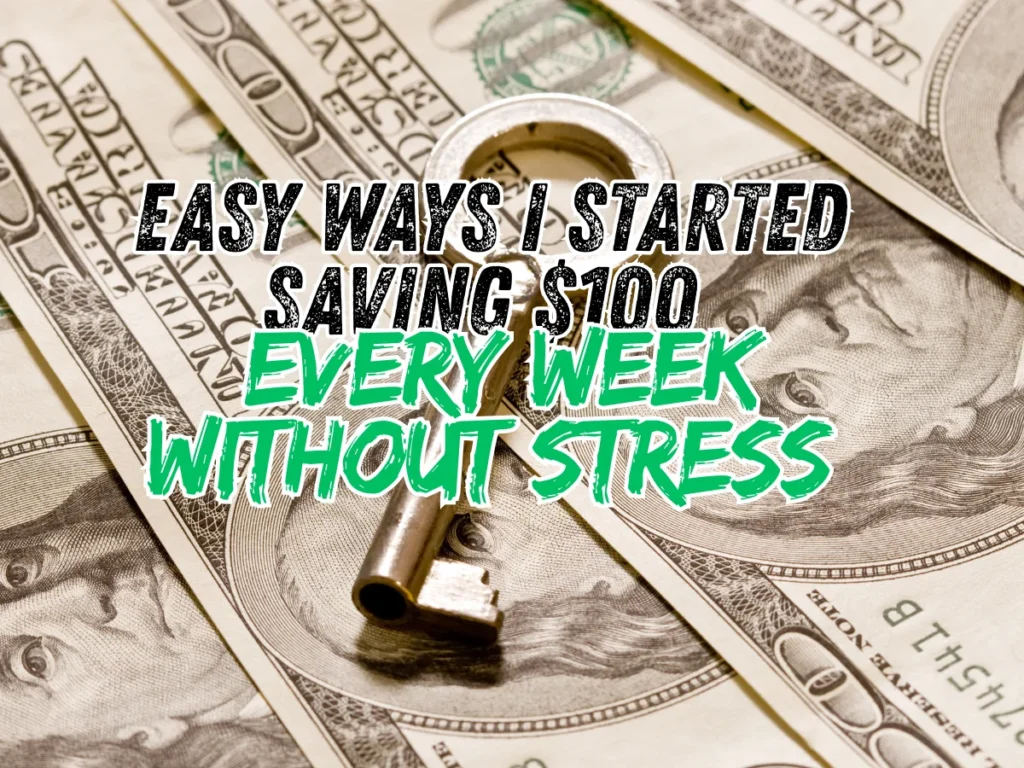A few months ago, I realized something kind of scary. I was getting paid every two weeks, but my bank account wasn’t growing. In fact, it felt like I was running in place. I wasn’t buying anything big or fancy, but the little things kept adding up — snacks here, subscriptions there, random online shopping when I was bored.
So I gave myself a challenge: Can I find a way to save $100 every week? That’s $400 a month, or about $5,000 a year if I stick to it. At first, it felt impossible. But once I started paying attention and making small changes, it got way easier than I expected. I didn’t need a strict budget or a big raise. I just needed a few simple habits.
Here’s exactly how I did it — and how you can too.

I Stopped Eating Out So Much
Let’s start with the big one: eating out.
Before, I would grab lunch at work almost every day. Sandwich here, fast food there — it didn’t seem like much in the moment. But each meal was at least $10. That’s $50 just during the workweek, not counting weekend meals or snacks. Sometimes I’d also order takeout for dinner when I didn’t feel like cooking. Add it all up and I was spending over $100 a week just on food outside the house.
So I decided to bring lunch from home at least 4 days a week. I didn’t get fancy. Some days it was just leftovers from dinner, and other days I made a quick sandwich or salad. I also started cooking simple dinners — pasta, rice bowls, stir fry — nothing fancy, just meals that made enough for lunch the next day.
That switch alone saved me about $50–$60 a week. Plus, I started eating healthier and feeling better too. Win-win.
I Cut Out Unused Subscriptions
One night, I went through my bank account and saw charges I forgot about. Three streaming services, two different cloud storage accounts, a music app, and even a monthly “mystery snack box” I wasn’t even excited about anymore.
I was paying over $70 a month on subscriptions I didn’t really use.
I canceled most of them. I kept one video service and my music account — the two I actually use every day. The rest? Gone. That move alone saved me almost $20 a week.
If you’re like me, you probably signed up for some free trials that turned into paid plans. Just take one hour and go cancel anything you don’t love or use often. It’s one of the easiest ways to save money without changing your lifestyle.
I Learned to Say “No” to Impulse Buys
I used to be terrible with online shopping. I’d be scrolling Instagram or watching YouTube and suddenly feel the urge to buy something — a new water bottle, a phone stand, a t-shirt that said something funny. It felt like fun in the moment, but those little $15 or $20 purchases really added up.
So I made a new rule for myself: wait 24 hours before buying anything that wasn’t food or a necessity.
It was kind of amazing. When I waited a day, the excitement usually faded, and I realized I didn’t really need that item. Some weeks I saved $30 or more just by not buying random stuff I didn’t actually want.
Now, whenever I see something cool, I just save the link and wait. If I still want it next week and it fits my budget, I’ll get it. But most of the time, I forget about it completely. That’s money saved and less clutter in my room.
I Used Coupons and Cashback Apps
I never used to care about coupons or cashback, but my friend showed me an app that gives cash back for groceries, and I decided to give it a try. I also started checking for promo codes before buying anything online.
It only takes a few minutes, but I started getting little rewards here and there — $5 here, $10 there. Some stores even offer discounts just for signing up with your email or downloading their app.
Over a few weeks, I realized I was saving $10 to $15 a week just by using these tools. It wasn’t much at first, but it added up fast. Plus, it made shopping a little more fun — like a small victory each time I saved a few bucks.
I Walked or Biked Instead of Driving
I live close to a grocery store and a few restaurants. Before, I would drive there, even if it was just a five-minute trip. I never thought about the gas I was using.
When gas prices went up, I decided to walk or bike when possible. For short trips, it worked great. I saved a few dollars on gas each week and got some extra exercise in the process.
If I had errands to run that were too far to walk, I tried to combine trips so I didn’t waste gas driving back and forth all week.
I figured I saved $5–$10 a week just by changing how I got around. That may not sound like much, but it helped me reach my $100 goal.
I Picked Cheaper Fun
I didn’t want to stop having fun, but I did want to stop overspending on entertainment.
Before, I’d go to the movies, grab snacks, or go out for drinks with friends. That could easily cost $30 or more in one night.
Instead, I started suggesting cheaper options: game nights, movie nights at home, walks at the park, or cooking dinner together. My friends didn’t mind. In fact, we started having more chill and meaningful hangouts — and we all saved money.
Most weeks, I saved $20 to $30 just by skipping expensive outings and choosing simpler plans.
I Added It All Up
Once I got into the habit, these little changes became second nature. I wasn’t living like a monk or giving up everything I enjoyed — I was just being a little more thoughtful with my money. Here’s what my average week looked like:
- Brought lunch and cooked dinners: Saved $50
- Canceled subscriptions: Saved $20
- Skipped impulse shopping: Saved $15–$20
- Used coupons/cashback apps: Saved $10–$15
- Walked or biked when I could: Saved $5
- Chose cheaper activities: Saved $20
That’s over $100 every week, just from small lifestyle changes. And none of them felt hard or strict. I still had fun, ate good food, and enjoyed life — I just spent smarter.
What I Learned
By the end of a few months, I had saved several hundred dollars, and it made a big difference. I used the extra money to pay off a credit card, build a little emergency fund, and even plan a short vacation. I felt more in control of my finances than ever before.
Here’s what I learned:
- You don’t need to be perfect. Some weeks I didn’t save the full $100, and that’s okay. The point is to aim for progress, not perfection.
- Small habits matter. Cutting $5 here and $10 there might seem tiny, but together they become something big.
- It’s not about sacrifice. I never felt like I was missing out. In fact, I enjoyed my new routines more because they were less stressful and more intentional.
If you’re looking for an easy way to save money without tracking every dollar, just try cutting a few small things and see what happens. You might be surprised — just like I was — at how fast $100 can stay in your pocket every single week.
And trust me, once you see those savings grow, it feels pretty amazing.
Check this out:
How to Launch a Cleaning Business and Earn £500,000 Annually
Starting a Vending Machine Side Hustle: Steps to Achieve $900 Monthly Income
A Guide to Profitable Reselling Businesses: From Zero to $20,000 a Month
